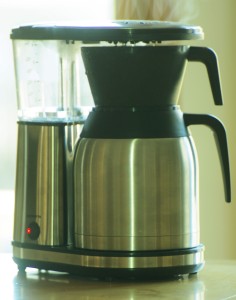Bonavita Automatic Drip Coffee Brewer 2014 Version (BV1900TS)

Several years ago, I was attending an SCAA event. Nancy Bloostein, of Oren’s Daily Roast nudged me and suggested I take a look at some new Melitta coffee makers. I ran (literally) over to see what appeared to be Technivorm knock-offs. They were labeled Melitta, but I was then told that they would appear on the marketplace soon under a new name, Bonavita. According to what I was told, Melitta licenses their nameplate to Hamilton Beach in the US. Therefore, although these were Melitta conceived and designed, no mention of Melitta would appear in the US market brewers.
Fast forward to 2014, Bonavita is now a treasured brand. What seems a simple proposition to make an excellent brewer priced to the average consumer, has long eluded most appliance brands. Even though it seems simple, apparently it is not. You need a smart design, one that gets the water almost-instantly hot, a spray heat that evenly disperses that hot water over the grounds, achieving even distribution, and gets the grounds thoroughly soaked, and gets all this done, start-to-finish, within 6 minutes.
So revolutionary was the Bonavita concept that it currently is the leading automatic drip coffeemaker. Bunn, Technivorm, Bodum, KitchenAid and Behmor all have fairly comparable brewers that compete, but somehow the Bonavita just seems to have an edge, when it comes to hitting the consumer sweet spot of price, performance, quality and ease. Remember if it isn’t easy, it isn’t automatic, is it?
So far, I’ve compared the Bonavita only to other automatic drip brewers. But as Third Wave Coffee has emerged, the bar has been lifted, as more consumers who use a Chemex, Hario or other manual brewer for their weekend or other special brews, want an automatic drip brewer to reach higher to match these inherently customized devices.
One interesting change: Bonavita has moved from the Melitta V-filter to the US-cupcake filter. Does this mean that Melitta no longer designs this brewer? Inquiring minds ponder this. Although I have found differences such as filter types to generally be outweighed by other factors, I philosophically agree with the reasoning that the cupcake filter spreads the grounds extraction task more evenly at the bottom, so I consider it a good (if shocking) move. I also applaud their resistance of the metal filter, which I consider overall inferior to paper in its ability to separate flavor compounds from grounds.
There are two things the Bonavita did not do as compared to manual drip. One is vary the brewing temperature. The other is match the intermittent pour that we use when we brew manually, which is especially important near the brew’s beginning when using fresh roasted coffee.
The new Bonavita offers only one brewing temperature, but they have gone out of their way to include a pre-infusion stage, which sprinkles ideally hot water over the grounds, then shuts down in order to allow a freshly-roasted, freshly-ground coffee to rise and fall appropriately, before continuously running hot water over the grounds.
So, how does it perform?
The new Bonavita handily meets every specification of an automatic drip coffeemaker, as did its predecessor. The brewing temperature is within the 196-205°F range. The brewing cycle (without pre infusion) is under 6 minutes. Pre-infusion adds around 30 seconds, as it should.
The ability to match intermittent brewing with your (or your barista’s) best efforts keeping pace with the water’s drip rate during brewing is not able to track as well as manual brewing, in my opinion the goal. Nor is it with the Behmor Brazen or any other yet-invented automatic brewer. What I can say, is I never had an overflow, no matter how fresh the grounds. I inserted a Chemex underneath the Bonavita, which is to be fair, not anything they suggest or offer to accommodate. The brew drip rate was simply too fast, even in the pre-infusion setting. But, this is more about how fast consumer expectations are rising, than any shortcoming on this brewer’s part.
What’s left? Well, the Behmor Brazen offers adjustable brewing temperatures and adjustable pre-infusion time settings. Will this matter to you? I cannot answer that, but I can say the Bonavita does a very, acceptable job with several coffees I’ve been using since it arrived one month ago.
Temple Roasters Panama Don Pepe Boquete Geisha is a light roasted delicate coffee that showed its full colors when brewed in the Bonavita. I was able to closely match what I could achieve in a Chemex.
Kean Coffee’s Nicaragua La Prometido is roasted slightly darker, or is it just the Diedrich roasting imprint? Not sure, but this stellar varietal comes through with its notes intact. This kind of roast is not for the timid (roaster that is). To catch it just before it starts to go caramel on us, is really a test of roasting skill. I was able to taste the full resolution of the coffee with the Bonavita.
Conclusion: The Bonavita took a good idea and made it better. There is not one thing I noted where I said, “Oh, I wish they hadn’t changed that”. Bravo!


